When it comes to installing a solar PV System, the solar panel mounting system may seem like a small component, but nevertheless it is vital that it is specified and installed correctly. After all, no one wants a leaky roof, or for solar modules to be insecurely attached. So here’s our guide to trusted mounting solutions for all different roof types.
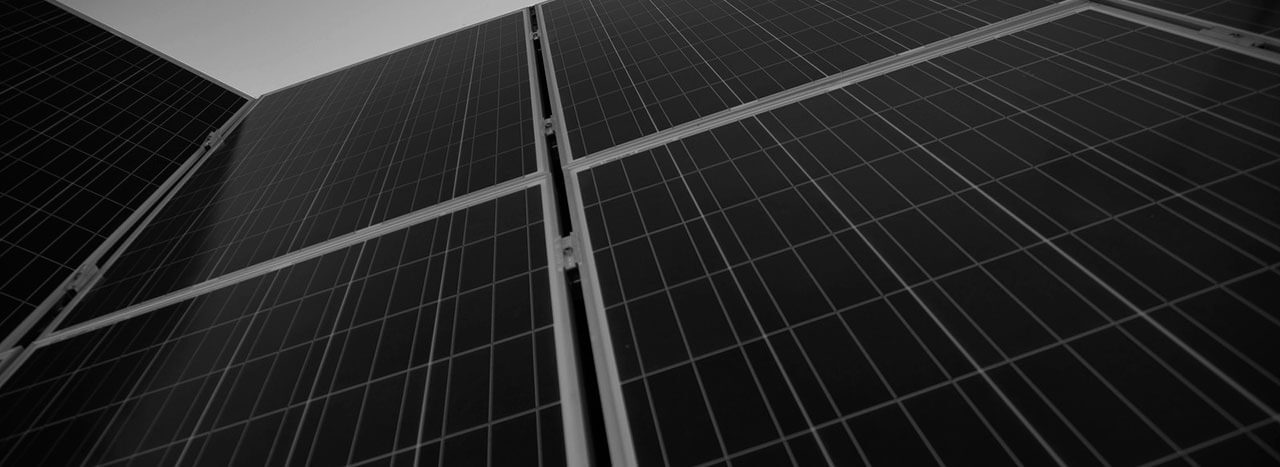
Solar PV Mounting Systems
Solar PV on Tiled roofs
To install solar PV on tiled roofs, our installers slide up the tiles to reveal the wooden roof joists underneath. A U-shaped hook screws into the joist, and the tiles slides back down over the hook – once again making the roof completely waterproof. Rails running across the roof are bolted to the protruding hooks, and the solar panels are bolted on to these rails.
See a case study of a tiled roof here

Solar PV on Slate roofs
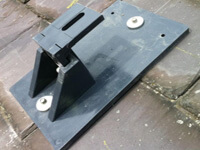
To install solar PV on a slate roof, our installers would use solar limpets. They drill through the slate into the rafter using two fixing holes, sealant is applied to the fixing holes and the base of the limpet. The solar limpet is then screwed onto the roof. Rails are then run across the roof and bolted to the limpets, and the solar panels are fixed to these rails (adjustable bracket).
See a case study of a slate roof here
Solar In-roof system
In-roof solar panel mounting systems provide a very aesthetic means of installing panels, by recessing the panels such that they lie flush with the existing roof surface. They can be installed from between 12 to 50 degrees pitch and either landscape or portrait. On a new build the roof can avoid tiling the area where the solar will go. A waterproof tray sits in the tile free area to provide waterproofing and the solar modules are then mounted on top of this.
See case study of an in-roof system here

South facing Solar PV on Flat roof

Flat roof solar panel mounting systems require a specific approach. To install solar PV on south facing flat roof we would use a ballasted system. This means the roof is not penetrated (which would let in water on a flat roof), and the system is unable to be lifted or tipped over by the wind. The triangular mounting frames are preassembled and placed on aluminium feet. The rows of panels must be spaced apart so that the row in front does not shade the row behind. This gap is roughly 500mm between the rear of one panel and front of another. Once in place, the ballast is then placed on the frame underneath the panels to hold it securely in place. The solar panels are then simply bolted to the triangular frame.
See a case study of a south facing roof here
E/W facing Solar PV on Flat roof
An alternative approach for flat roofs is to use and E/W system. Because the sun shines ‘down the valleys’ it is not necessary to space the modules apart. Using an E/W system results in a higher installed capacity on the same roof area. The panels produce about 85% of optimal, but this is offset by economies of scale. We often see better rates of return on investment using this approach compared to S facing rows.
The east-west solar panel mounting systema are similar to the south facing system installation however the panels are placed back to back, and there is a smaller gap between rows (180mm). A further advantage is that the ballast requirements are lower for this system as the structure is more enclosed and there is nowhere for the wind to ‘catch’.
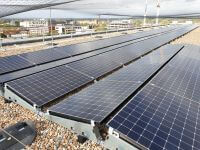
The Sika SSM1 Solamount

The SSM1 solar panel mounting system is non penetrative and is suitable for flat roofs up to 5⁰. It is installed on a single ply Sika Sarnafil waterproof membrane. The racks provide an elevation of 15⁰. The solar mounting system is assembled and the assembly rails and jigs are placed across the mounts. The mounts are then welded to the waterproofing membrane using fixing flaps on the Sika SolarClick FPO or PVC system. Because the mounting system is essentially stuck to the roof, very little additional ballast is required compared to other flat roof systems. The paving stone ballasts are incorporated and the panels are attached to the frame.
Sika Sarnafil has a single point 20 year guarantee for the roof and solar combined. There is also only one contractor for the roof and solar so provides simplicity to the process.
Solar PV on Trapezoidal Metal roof (Kingspan)
Installing solar PV on a trapezoidal metal roof, such as Kingspan, is the cheapest and fastest means of deploying solar panels. Metal clamps are Tek-screwed into the top of the trapezoidal profile; these clamps have a rubber backing to ensure waterproofing. The solar PV modules are clamped directly to these clamps.
See a case study of a trapezoidal metal roof here

Solar PV on Standing Seam Roofs (Kalzip)
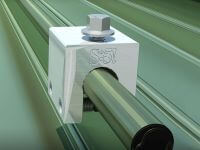
For standing seam roofs, such as Kalzip, clamps are available that clip over the ridges of the standing seam and are fastened with a screw at the side. A variety of sizes are available to suit all different types of seam. The solar PV modules can then be bolted directly to these clamps.
See a case study of standing seam here
Ground Mounted Solar
Ground Mounted solar is a great option if your roof is unsuitable for solar PV, and you have land available that you are prepared to give over to electricity production. A metal framing is put into the ground via metal ground screws, and these hold the solar PV panels at a fixed angle. The PV panels are attached to the frame.
See a case study of a ground mounted solar install here

Solar Roof Tiles
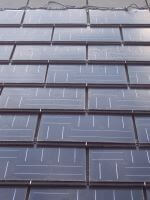
Solar roof tiles are undeniably the most attractive way of incorporating solar PV into a roof, and are a great product to use on high-end building projects. Solar roof tiles are simple to install and can be installed by a conventional roofer. However, because they are a more bespoke product, the cost is currently 2-3 times that of a regular solar module system, and if price is a concern you may wish to look at in-roof solar panel mounting systems instead. There is currently a lot of attention being generated by the Tesla Solar Roof tile (not yet available, but coming soon) but these products have been around for a long time. Indeed, Joju’s very first installation in 2006 was with solar roof tiles.
See a case study of solar tiles here
Solar PV on Green roofs
Prior to the installation of the green turf roof a single ply membrane will be installed to ensure that the roof is waterproof. Plastic plates (base) which are part of the mounting system are laid down on the roof. There are metal uprights that raise upright off the pad. The contractor puts down soil over the plates which acts as both a ballast for the solar PV and a growing medium for the plants. Rails and panels are then installed on the metal upstands.
See a case study of a green roof here

Solar Glass Laminates
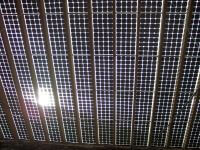
Instead of being assembled into a solar module with a plastic backing cover, solar cells ca be placed between two sheets of glass. The cells can be spaced out more than in a regular module and this allows 10-20% of light through. This is a great option for conservatories, walkways, atria and high-end office buildings. The solar glass can also be used to provide passive temperature control by blocking out much of the summer sun.
Solar Plant Screens
Solar plant screens can be used to hide building plant on the roof. Plant screens can incorporate solar into their design and fit the needs of the roof .
Louvres can also be designed to incorporate solar panels. There are different types of louvres and some make installation easier than others. The Crossrail is put across the louvres and attached to the main poles. The panels are then attached to the crossrails. The panels are installed parallel to the louvres.
See a case study of a louvre system here

Solar Carports

Solar carports are overhead canopies that cover car parking areas. The structure of the carport is often steel and consists of a lattice of rails which the panels are then attached to. This system can either relay the energy back to the main building on site or be integrated with battery storage and EV chargers.
Solar Pergolas
Solar Pergolas is a garden structure that can provide shelter whilst also incorporating a solar glass covering to produce energy. They can be considered a more beautiful and functional version of a ground-mount solar array – one that you can sit and have your summer evening meal under!




